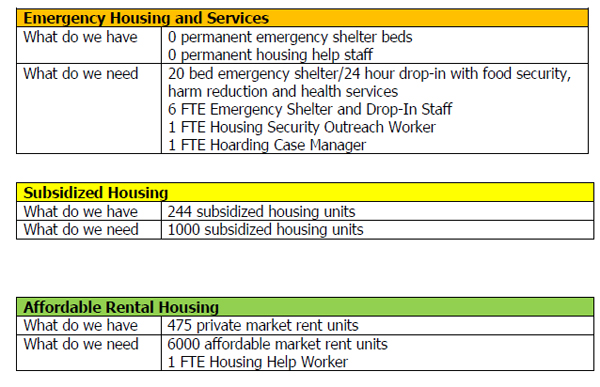Plan designed to help house homeless and seek support services
Administrator | May 09, 2023 | Comments 0
On the heels of a receiving a ‘County Housing Plan’ council unanimously supported a motion by Mayor Steve Ferguson that asks the Affordable Housing Corporation to go after physical space to help those experiencing homelessness.
“Over the years there has been an awful lot of hand-wringing amongst social service agencies, councils, staff about how best to address the problem that we knew existed, but there was nothing specific in front of us until today,” he said pointing to the plan, presented by the Affordable Housing Corporation. “I don’t recall a report to council that so clearly articulates and is a call to action to deal with the problem that will likely grow and expand in the months and years ahead.”
The plan was designed as a “living document” to assist the housing corporation and the 15 community agencies involved to apply for provincial and federal funding to improve housing opportunities, and support services, in Prince Edward County.
It documents income and demographic trends and housing stock from emergency, supportive and subsidized housing to affordable rental housing stock and services which support residents with housing insecurity. It does not reflect any market real estate.
It was developed in response to the fact housing has become problematic with untenable waiting lists for subsidized housing, market rents increasing at unprecedented rates, and vacancy rates being the fourth lowest in the province (.2 per cent) among rural communities.
Elis Ziegler, Housing Programs and Services Assistant, told council solutions can come from anywhere and be all things, including creating more housing, supplementing income, matching seniors with people who could live with them, finding emergency and transitional housing.
CAO Marcia Wallace clarified that because funds are based on population, the County may qualify for one third of the more than $2.4 million in funding the province recently announced for Prince Edward – Lennox and Addington Social Services (PELASS). Any application for funds, she added, would need to be based on real projects with real ideas.
Chuck Dowdall, executive director for the housing corporation added there are a few viable projects in the works that could qualify.
The Housing Plan report states that currently, there are no service coordination measures available to County residents to help mitigate the threat of eviction, have access to housing, or provide some form of stabilization and states “The result is that visible homeless will continue to increase in the County without a permanent shelter accommodation established and a coordinated service support established.”
Kathy Kennedy, executive director of the Prince Edward Learning Centre, told council the centre is hearing from more residents than ever before who are sleeping on couches or in doorways, living in tents, in their cars, and sometimes in hotels for short terms, supported by PELASS or the Salvation Army.
“These are bright, hopeful, creative and resilient young people who manage to with immense struggle participate in employment training despite the lack of a very basic need.”
A former nurse told council how she lost her job and then her home when her health started to decline. She has lived in her car, in trailers and on couches. She stated she couldn’t go to a shelter because she didn’t want to give up her dog, and thanked a woman for taking them into her home last winter.
“Many people who are chronically homeless have a form of disability, lack of support system and community,” she said. “They are on fixed income and can’t keep up with the price of rent and food.”
Ziegler’s report also states the housing plan was developed because the County did not have a specific prescriptive plan and has relied to this point on PELASS, the dedicated Consolidated Municipal Services Manager, which “unfortuantely does not include the full range of housing available nor accurately reflects current housing conditions in the County.”
The plan was developed from the Housing and Poverty Reduction Action Team of the Community and Safety and Well-Being Plan, led by co-chairs from Prince Edward Learning Centre and The Prince Edward County Affordable Housing Corporation (PECAHC).
It was reviewed by 15 community service agencies in the County, with key informants being the County Foundation Vital Signs, Prince Edward Learning Centre (PELC) and the Prince Edward-Lennox & Addington Social Services (PELASS).
The 30 agency and municipal representatives met in April to review the plan. The document includes the history and current state of housing; a needs assessment, a five-year plan and best practice approach.
Click here to read the document.
A few interesting highlights include:
– The County’s population as of the 2021 census is 25,704 residents with modest growth since 2006. Of those residents, the median age is 56.8, indicative of the increasing older population, 15 years older than the provincial average in 2021.
– Meanwhile, with population growth trending upward for families with children to the County even before the pandemic, this migration intensified during the pandemic resulting in a boost in the youth population. The increase in incoming youth is creating an overflow in primary classrooms and a long waiting list for childcare (The HUB Child & Family Centre). However, Ontario only has licensed child care space for 20% of all children. (Child Care Ontario),” states The County Foundation.
– Census Canada reported 1,335 household dwellings in Prince Edward County. Owned housing made up 82 per cent of those households, while tenant households consisted of 18 per cent of the remainder. Of those tenant households, 12.8 per cent live in subsidized housing, which extrapolates to 5 per cent of tenanted households in market rent units.
– The County as a nationally identified vacation destination, saw seasonal residents in their own properties increase to 25 per cent of the population to a level of 850 households in 2022, further depleting the existing housing stock. In combination with seasonal residents, vacation accommodation was at a premium. Enter on-line booking platforms,
filling the gap with short-term accommodation in residential properties, which grew to over 900 active licenses in 2023, reducing the amount of housing available.
– The value of the real estate market in the County is disproportionately higher than homes elsewhere in the region.
– Of those available rental units, amounts have increased similar to average home prices, and are 23 per cent to 142 per cent compared to CMHC average rents for the region.
– 30 per cent of County residents are deemed to be low-income and unable to afford real estate or rentals. Other special population groups directly impacted by lack of affordable housing include seniors, people with disabilities and workers. Ontario Works assists 413 people (253 adults, 160 children) and ODSP (1200 households)
– There are two property owners operating short-term/emergency housing in Prince Edward County, but neither are regulated, nor formally attached to any service provider. Further, there are no drop-in services for people who are homeless nor overnight accommodation facilities except for an informal and unfunded response to homelessness. Without a County-based emergency housing service, there is no outreach or point of contact for people who don’t have permanent housing to provide support or maintain accurate data for planning purposes.
– People who hoard to the extent their residence is no longer habitable is a mental health crisis, compounded by potential loss of housing and belongings. There are as many as 10 cases a year in the County.
– As of March 31, 2023, there are 43 households on the waiting list for subsidized housing in PEC. The following table details the number of applications for each type of subsidized unit, and their approximate wait time:
252 for one bedroom – seven years
78 for two bedroom – nine years
74 for three bedroom – eight years
29 for four bedroom – seven years
The housing corporation is creating 52 units of affordable housing on Niles Street in Wellington to host 40 households in a combination of a 36-unit building and four three-bedroom townhomes. And on Disreli Street in Picton, a 12-unit singles housing development with 50 per cent of the units for youth employed by the County supported by Mohawks of the Bay of Quinte is to be occupied by 2024.
Public/Private partnerships are also being discussed to manage 600 affordable housing units within private residential developments being built in the County in the next three years.
Filed Under: Local News
About the Author:
































